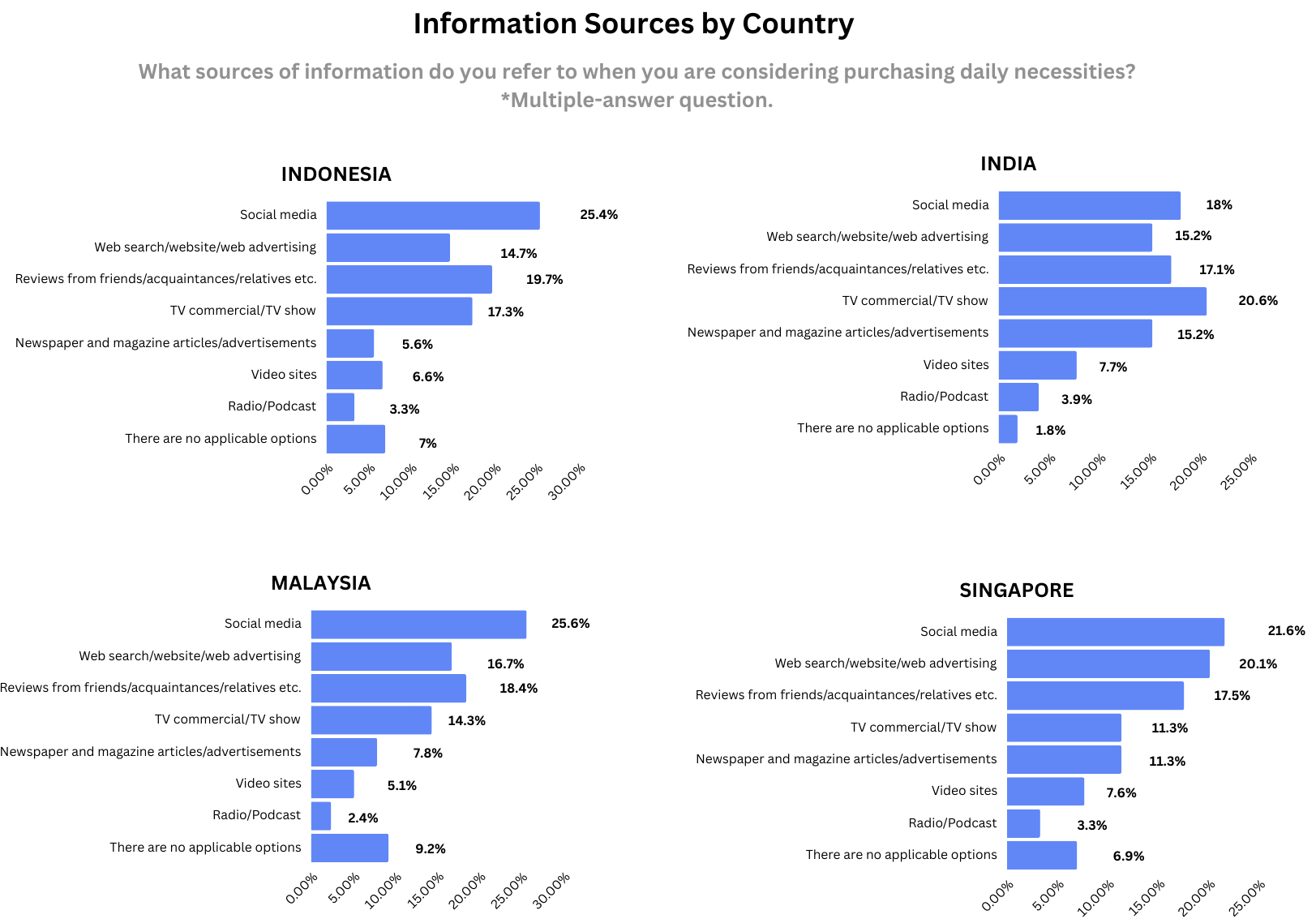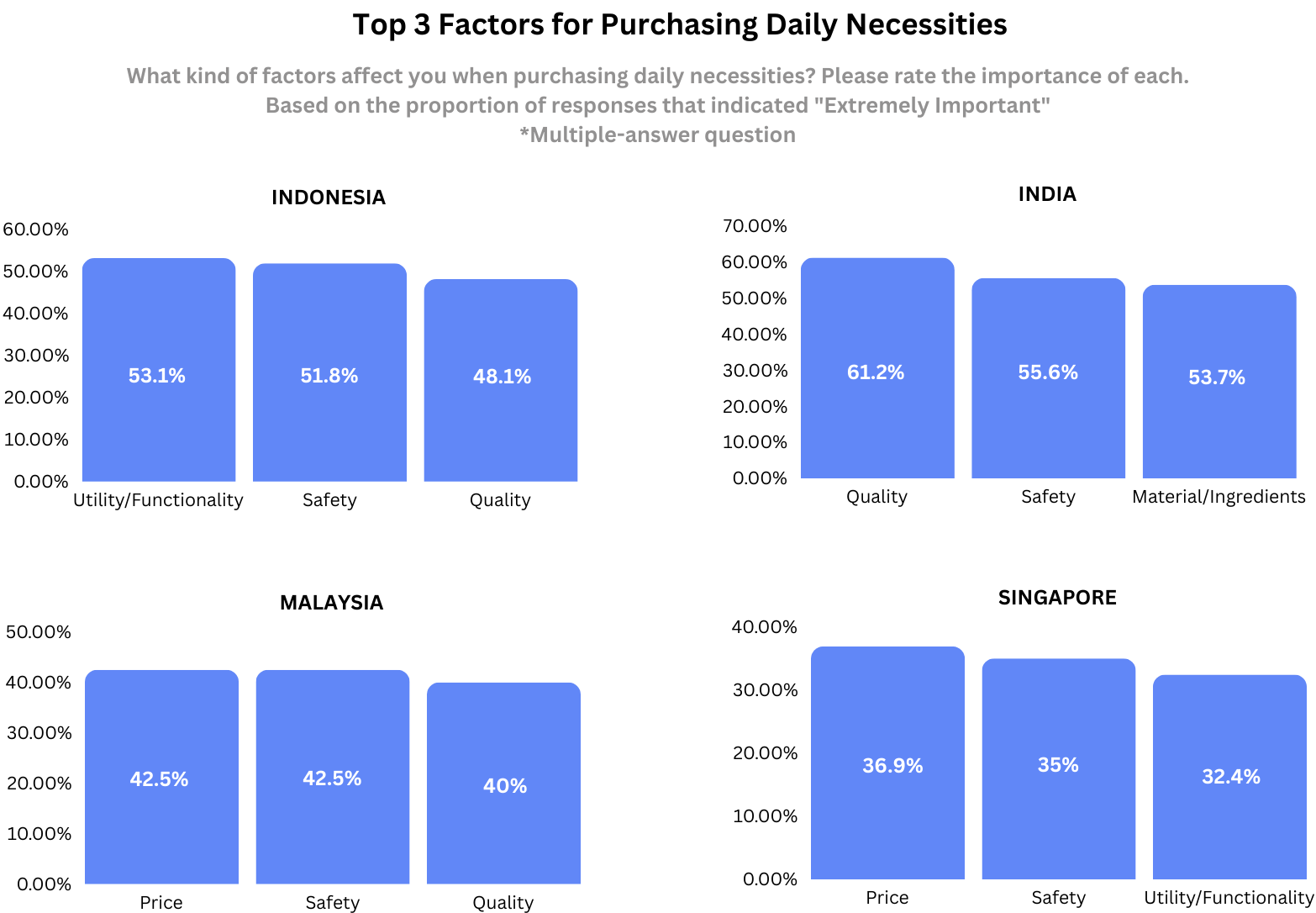Trends in the Daily Necessities Market in Asia: Consumer Behavior and Strategic Approaches
2024/06/07

Between April 19 and May 1, 2024, a consumer trend survey was conducted across four countries: Singapore, Indonesia, India, and Malaysia. This survey targeted general consumers aged 15 to 59, delving into their purchasing behaviors concerning groceries, daily necessities, clothing, entertainment products, and general imported goods. In all the surveyed countries, overall consumption is expected to increase over the next year, indicating a positive trend towards spending.
Based on the results of this survey, this article provides an in-depth analysis of market trends in each country, focusing on expenditure on daily necessities, purchasing behaviors, and brand preferences, offering insights valuable for business strategies.
General Findings
Analyzing the consumer trends in each country revealed the following key characteristics:
-
Priority of Expenditure: The percentage of respondents who chose daily necessities as the category they spent the most on in the past year was about 15% on average across the four countries. However, for the category they expected to spend the most on in the next year, 21% chose daily necessities, indicating a growing awareness of the importance of daily living and potential growth in the daily necessities market.
-
Shift to Digital Channels: Supermarkets remain the primary purchase channel, particularly in Singapore and Malaysia. However, a significant number of consumers also use online shopping, highlighting the importance of digital channels.
-
Importance of Price, Safety, and Quality: Consumers consistently prioritize "price," "safety," and "quality" when choosing daily necessities. In some countries, "functionality" is also a significant factor, indicating a diversification of consumer needs.
-
Differences in Brand Loyalty: Consumers in Singapore and India exhibit high brand loyalty, while those in Malaysia and Indonesia are more flexible in their brand choices.
Characteristics by Country
Most Frequently Purchased Daily Necessities: Overall, "bath products," "kitchen products," "toilet products," and "laundry products" are the most frequently purchased categories in many countries. However, in Malaysia, "health and beauty products" are purchased almost as frequently as bath and kitchen products, indicating a high level of health and beauty awareness among Malaysian consumers.
Sources of Information: When considering sources of information for purchase decisions, "social media" is widely used across all countries. However, in India, "TV commercial/TV show" slightly surpasses “social media,” suggesting that “TV commercial/TV show” still holds significant influence. In Singapore, "web search/websites/web advertisements" account for almost the same proportion as"social media,” indicating a shift towards digital consumer behavior.

Important Factors: "Price," "safety," and "quality" are consistently valued across all countries. In Indonesia and Singapore, "Utility/Functionality" is also highly valued. This suggests that as basic needs for daily necessities are met, consumers are increasingly seeking advanced features and convenience. In contrast, in Malaysia and India, "Utility/Functionality" is somewhat less emphasized, and the essential aspects of the products are more highly valued.

Purchase Channels: "Supermarkets" are the main purchase location in most countries, but on average, about 20% of purchases are made online across the four countries. In India, the online shopping usage rate is as high as 31%, indicating that online shopping is an attractive option for consumers seeking time savings and delivery convenience.

Brand Loyalty: Consumers in Singapore and India exhibit high brand loyalty, with over 20% of Indian consumers in many categories indicating that they "always purchase specific brands," demonstrating strong trust in brands. On the other hand, consumers in Malaysia and Indonesia show greater flexibility in brand selection. In Malaysia, the proportion of respondents who "always purchase specific brands" is low in many categories, indicating that these consumers are more likely to choose products based on price, quality, and functionality rather than brand alone.
Interest in Trends: About 40% of consumers in all four countries indicated that they are "interested and would like to try new products if given the opportunity." In India, 40% of respondents also indicated that they are "very interested and eager to try new products," which is about 30 points higher than the other three countries. This suggests that Indian consumers are highly sensitive to trends in daily necessities.
Strategic Insights from Market Data
Considering these characteristics, here are some strategic insights for the grocery industry:
-
Strengthening Online Channels: Companies should leverage the convenience of online stores and enhance digital marketing. Utilizing SEO, SNS ads, and influencer marketing to reach target audiences is crucial. Improving the ease of online shopping to provide a seamless purchasing experience is also necessary.
-
Emphasizing Quality and Safety: Marketing messages highlighting product quality and safety are essential to gain consumer trust. In markets like Indonesia that value "functionality," emphasizing the convenience and unique features of products can be effective.
-
Enhancing Brand Value: For consumers in Singapore and India, strategies to strengthen existing brand value and maintain brand loyalty are effective. Consider narrowing the gap between company branding and consumer brand image through appropriate storytelling and implementing loyalty programs.
-
Opportunities for New Brands: In markets like Malaysia and Indonesia, new brands can expand market share by offering differentiated product features and excellent cost performance.
Conclusion: The Role and Value of Marketing Research
This survey shows how differing approaches to daily necessities and consumer expectations vary across countries. Strategies tailored to these insights are the key to success in each region.
For companies looking to strengthen their business in domestic and international markets, leveraging marketing research to understand consumer behavior patterns and preferences in detail is essential for strategic decision-making. Understanding how their products and services are received in the local market through research and designing and executing effective approaches based on data can enhance competitive advantage and achieve sustainable growth. Strengthen your market position and realize sustainable growth through marketing research.
Survey Theme: Consumer Trends in Asia
Survey Areas: Singapore, India, Malaysia, Indonesia
Survey Targets: Men and women aged 15-59, a total of 640 people (160 by each country)
Survey Date: April 19 - May 1, 2024
Methodology: Internet survey (closed survey)
This survey was conducted using our "Quick Survey"
|
Our Quick Survey service is fast, affordable, and easy to use. Perfect for businesses in APAC, it quickly finds survey participants and gathers data, making it ideal for simple data collection. Obtain authentic consumer feedback promptly and make swift, data-driven decisions to capitalize on business opportunities. |

Related Articles



Find out what consumers prioritize when they purchase groceries, and how diverse purchase channels are transforming the market.
Understand the strong brand loyalty in certain regions, the importance of online shopping, and the balance between following trends and personal style.
Understand how digital content and social media are reshaping entertainment consumption in Singapore, Indonesia, India, and Malaysia.
